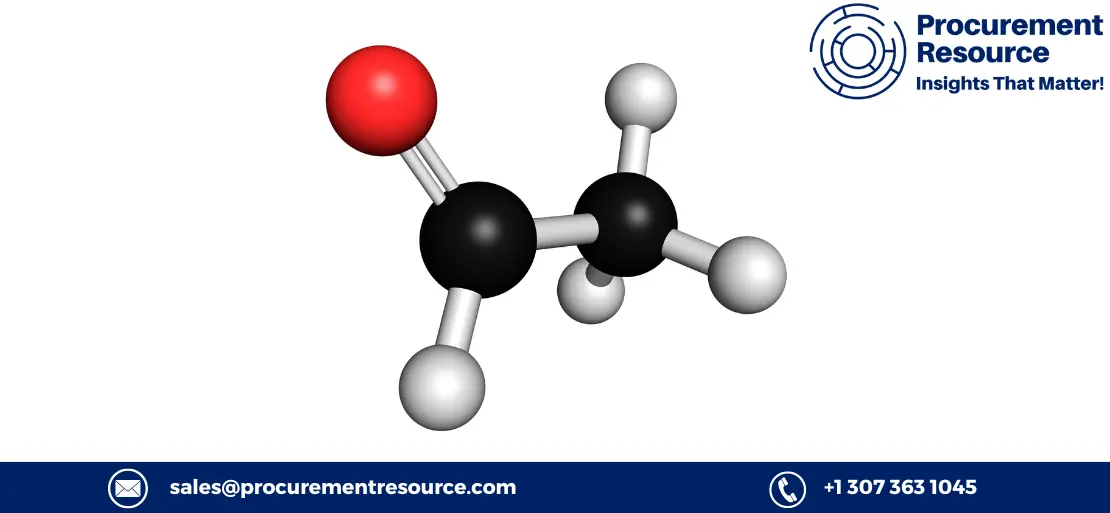The Market Overview of Acetaldehyde and its Growing Demand

This blog contains in-depth information on acetaldehyde and its industrial uses, production process, pricing analysis, and key market players.
Acetaldehyde and its Industrial Applications
Acetaldehyde is an organic chemical compound and is a colourless organic liquid in appearance. It has the molecular formula C2H4O and has a very pungent and suffocating odour. It is highly soluble in water and is non-corrosive to various metals. It can damage organs like the liver as it is toxic in nature. The molecular weight of acetaldehyde is 44.05 g/mol and its density is 0.784 g/cm3.
Request Access For Regular Price Update of Acetaldehyde
The boiling point and melting point are 20.2 °C and 123.5 °C. respectively. It is extensively employed as an intermediate for producing acetic acid and in the manufacturing of perfumes, dyes, flavouring agents, and drugs.
The market for acetaldehyde is heavily fueled by its principal uses, particularly in the manufacturing of chemicals. Moreover, it is employed in the production of acetic acid, resin, disinfectants, etc. It also finds its application as a precursor to croton aldehyde, pentaerythritol, and pyridine derivatives. Additionally, it is also used in the manufacturing of polyvinyl acetate.
It is used in the food industry to make vinegar and yeast as well as a preservative for fish and fruit. Moreover, it is used as a solvent in numerous industrial processes, including the production of paper, leather tanning, and rubber. It is used to make n-butyraldehyde and is employed as an alcohol denaturant, a gelatin fibre hardener, in fuel mixes, glue, and casein products.
Production Process of Acetaldehyde
From Ethylene: Acetaldehyde is made from ethylene via the Wacker process, which also involves oxidising ethylene with a homogeneous palladium/copper combination to produce acetaldehyde. This method is one of the most well-known ways to prepare acetaldehyde for industrial use.
From Ethanol: Acetaldehyde production through ethanol marks its initiation by the ethanol dehydrogenation process. The ethanol vapour is then passed over a copper-based catalyst at 260–290 °C in an endothermic process to yield acetaldehyde and hydrogen gas as a by-product.
From Acetylene: Using mercury (Il) salts as a catalyst, acetaldehyde is created by hydrating acetylene. The reaction occurs between 90 and 95 °C, and the acetaldehyde that is produced is separated from the water and mercury and refrigerated.
From Acetic Acid: Acetic acid hydrogenation is used to create acetaldehyde from acetic acid. It comes from the production of ethyl acetate.
Key Players in the Market of Acetaldehyde
- Celanese
- Merck KGaA
- Sumitomo
- Sekai
- Jubilant Life Sciences
- LCY Chemical
Acetaldehyde Price Trend
North America
Recently, the price of acetaldehyde in the US market showed a shifting emotion. Because of the weak price pressure from the price of the feedstock ethanol in the beginning, the price of Acetaldehyde fell. The availability of surplus material drove the price of acetaldehyde lower while the demand from end-user sectors, such as the food preservation sector, remained muted. However, as ethanol prices rose, the price of acetaldehyde recovered in the latter phases.
Prices in the local market increased as a result of the limited supply of materials and increased demand from the end-user market. Notwithstanding the fact that the prices of acetaldehyde decreased due to unfavourable demand dynamics during the slow season.
Asia Pacific
Acetaldehyde prices in the Asia-Pacific area showed a swinging pattern. Due to increased demand from downstream food preservation businesses and other competitive markets, as well as a slowing in buyer sentiment in the local market, Acetaldehyde prices decreased in the Chinese market. But, because of the end-user industry's increased demand, prices increased.
Also, the manufacturers were affected by the ongoing lockdown during the zero covid policy because they experienced a labour shortage and a disturbance in the supply chain, which largely had to do with logistical issues. In spite of this, the prices began to decline. Also, as the Covid-19 outbreaks continued to exert pressure on the demand and output, industrial activity decreased.
Europe
In the beginning, there was conflicting market opinion in Europe regarding acetaldehyde prices. Because of the material's abundant supply and decreasing demand from the food preservative and other competitive markets, acetaldehyde prices have recently fallen. Low acetaldehyde production cost is the result of lower feedstock ethanol prices.
Despite the significant cost pressure from the feedstock ethanol, the price of acetaldehyde has recovered. Based on domestic output, the rates of operation remained within bounds as long as energy prices kept rising. Notwithstanding this, the industry transactions have been operating at a lower level because the downstream demand has been affected by inflationary pressures.
Read More About Acetaldehyde Production Cost Reports - REQUEST FREE SAMPLE COPY IN PDF
However, as the Covia-19 outbreaks continued to pressure both demand and output, production activity decreased. So, according to many authorities, a purchasing manufacturing index below 50 denotes a decline in both manufacturing and industrial activity.
Product price, market analysis, and information on a variety of products are provided by Procurement Resource. Procurement Resource's primary service is industry analysis and evaluation. The customers have access to up-to-date information as well as correct pricing models, benchmarking, and category analytics.

COMMENTS (0)